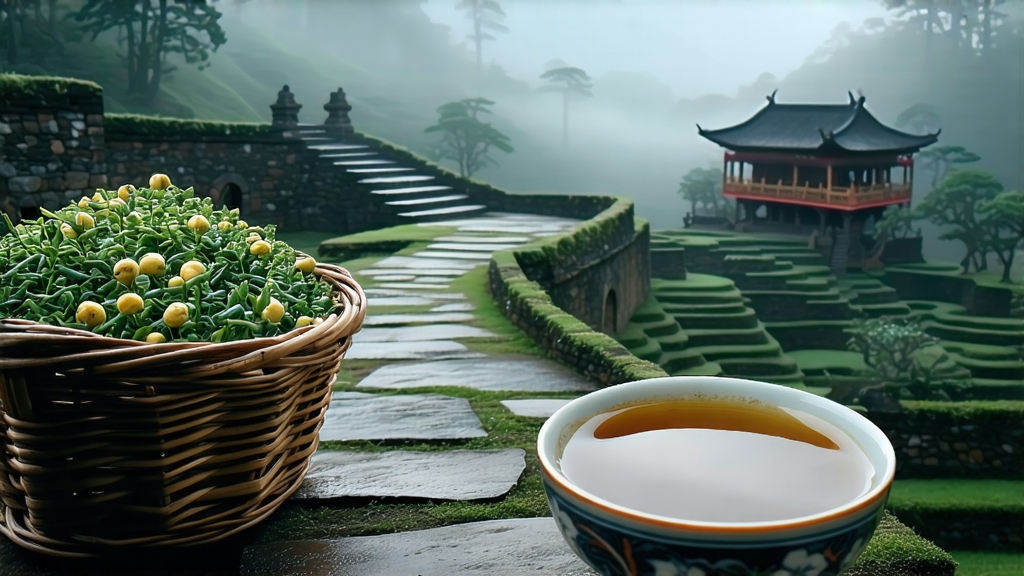
Tucked high on the northern rim of the Sichuan Basin, where the Min River carves misty corridors between 30- and 35-degree north latitude, lies the legendary Meng Ding Mountain. For twelve centuries its cool cloud veil, quartz-rich soil, and 1,500 mm annual rainfall have conspired to produce one of China’s most discreet treasures: Meng Ding Huang Ya, the “Yellow Bud from the Summit of Meng.” Unlike the better-known green teas of neighboring Emei or the dark bricks of Yunnan, this yellow tea remains a whispered secret even inside China, its annual yield rarely exceeding 3,000 kg. Yet its story is inseparable from the birth of tea itself; it was here, in 53 BCE, that the ascetic Wu Lizhen is said to have planted seven bushes that became the first garden of grafted Camellia sinensis. When Tang-dynasty poet Meng Haoran climbed Meng Ding in 720 CE he wrote of “golden shoots steaming in the morning sun,” the earliest literary reference to what would later be codified as huang cha, yellow tea.
By Song times the buds were pressed into silver-molded cakes and rushed by fast horse to Kaifeng, fetching three times the price of dragon-phoenix tribute cakes. The Ming abolition of compressed tea forced Meng Ding monks to reinvent their craft, developing the slow “sealed yellowing” that distinguishes the category today. Qing emperors renewed its tribute status: the 16-year-old Kangxi received Meng Ding Huang Ya at his wedding banquet in 1665, and the 7.9 km “Imperial Courier Road” with 7,600 stone steps was built expressly to carry the harvest downhill within 36 hours. After the fall of the dynasty the gardens lapsed into wildness; only in 1959 did Premier Zhou Enlai, recalling the tea from his Chongqing years, order restoration of the ancient terraces. The state-designated 13.2 ha original core garden is now a UNESCO Globally Important Agricultural Heritage Site, and every April the county magistrate reenacts the Qing-era “Opening of the Spring Buds” rite before picking can begin.
Meng Ding Huang Ya is not a single clone but a micro-ecotype of the local small-leaf landrace known as “chuan cha qun ti zhong.” Three sub-varietals survive: the original “Shí Qī” (Stone Banner) growing on precipices reachable only by rope, the heart-shaped-leaf “Bái Háo” prized for its silvery down, and the late-sprouting “Wǔ Yè Qí” that extends the season into early May. Buds must be taken at the “sparrow’s tongue” stage—exactly 2.0–2.3 cm long, unopened, weighing 0.12 g each—between Qingming and Grain Rain when morning mist keeps leaf temperature below 18 °C. One kilogram of finished tea demands 42,000 such buds, hand-plucked by villagers who still observe the rule “no fingernails, no perfume, no breakfast garlic.”
The craft sequence follows five ancient verbs: kill, wrap, pile, seal, breathe. Sha Qing (kill-green) is done on a 160 °C bamboo-roofed wok for 4 minutes with 45 tosses per minute, stopping oxidation at 12 %. While still 60 °C the leaves are wrapped in 60 × 60 cm squares of steamed yellow paper—Meng Ding’s unique “men huang” step—and left to sweat for 40 minutes. The bundles are then piled 5 kg high in a 28 °C, 75 % RH bamboo chamber for 48 hours, turned every 12 hours to ensure even yellowing. A final low-temperature bake at 55 °C for 3 hours reduces moisture to 5 %, after which the tea “breathes” in reed baskets for seven days so residual enzymes complete the mellowing. The result is a leaf that is olive-green at the spine, canary-yellow at the margin, and downy silver at the tip—colors that inspired the Song saying “three hues of spring on one bud.”
Western drinkers often confuse yellow tea with lightly oxidized oolong or aged green tea. The difference lies in the non-enzymatic browning that occurs during sealed yellowing: catechins polymerize into theaflavins and thearubigins without reaching black-tea levels, while amino acids convert to